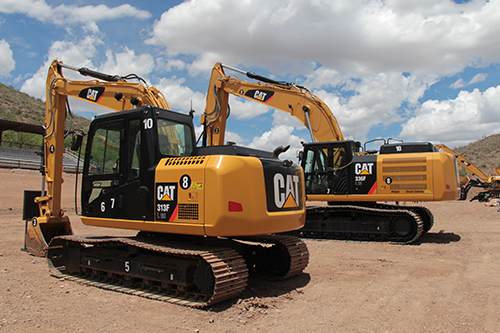
Now that heavy-equipment manufacturers are closing the hood on a decade-long overhaul to meet stringent diesel-emission limits, known as Tier 4, research-and-development budgets are shifting to make those cleaner-burning—and more expensive—engines more efficient.
“We have customers coming in and trading in older machines because of what they can save with fuel efficiency,” said Paolo Fellin, Caterpillar’s vice president of global construction and infrastructure at its Tinaja Hills Demonstration and Training Facility, near Tucson, Ariz.
Even in this time of low oil prices, fuel still represents, on average, 30% of operating costs for construction equipment users. When some machines burn dozens of gallons of diesel fuel per hour, costs can add up quickly. Cat is taking a multipronged approach that includes helping users reduce idle time, improve operator technique, select better machines for the task, integrate fleets with big data and design streamlined worksites.
Due to the internal computers needed to monitor emission levels, Caterpillar has produced more big data from machine operations in the past five years than during its entire company history, Fellin said. The company now is trying to use that data to help construction users streamline their operations.
“We are trying to take technology to the jobsite,” Fellin said. “We are trying to become obsessed with the jobsite, instead of just the machine itself.”
Use of big data and telematics to improve efficiency is growing globally, he added. “The adoption of this technology is just as strong of a pull in the developing world as it is in the developed world.” In remote places like Africa, “repair is even more and more complicated,” Fellin added.
Several new machines introduced at Cat’s Tinaja Hills demo facility reflected this fuel-economy mandate. The company has spent more than $120 million on its large articulated hauler platform, including the new 745C, which is one ton lighter than the outgoing model.
Cat claims the machine is 10% more fuel-efficient and 12% more productive, aided in part by a new nine-speed CX38 high-density automatic transmission, similar to ones used in the BMW 7 Series and other luxury automobiles. The first rugged, off-highway application of this type of transmission, it has 18% fewer clutch packs and weighs 50% less than the previous powershift transmission, despite having two more forward speeds.
A second hydraulic-hybrid excavator has joined the Cat lineup, and it promises to burn 20% less fuel than its non-hybrid sibling. The 336F XE is a 36-ton excavator whose 308-horsepower engine is supplemented by a hydraulic-hybrid swing pump. The savings the system delivers in carbon dioxide is the equivalent of taking 12 cars off the road, Cat says.
Not all new machines need to be high tech, though. Part of several manufacturers’ plans is to offer more value-grade machines. Think of them as the economy-car version of the heavy-equipment world.
One such machine is Caterpillar’s new 313F L GC, a 15-ton excavator designed for rental fleets, small contractors and other light-duty users. Engineers designed the new GC model around a 74-hp engine, one horsepower shy of needing selective-catalytic reduction and urea fill-ups under Tier 4 emission requirements. Sidestepping Tier 4 complexity in a low-production model effectively helps users avoid the maintenance costs associated with heavier-duty machinery.
Some producers are going so far as to back up their fuel-economy claims with refund programs if users burn more fuel than predicted. Volvo introduced such a program in 2010, and Cat now has followed suit. Cat’s program, announced on May 15, is available for more than 100 machines through Dec. 31.
Operators are just as much a part of the fuel-economy equation as machines. Eventually, Cat plans to release more autonomous machinery and automated machine guidance to help operators meet stricter efficiency goals. It is actively testing autonomous haul trucks and bulldozers for mining operations and incorporating watchdog technologies, such as cameras that monitor operators’ eyelids and facial expressions to make sure they are alert and focused.
“We believe we have to have that capability,” said John Carpenter, manager of construction technology and solutions, speaking of autonomous machines. “I think economics are going to drive how far that goes.”







Post a comment to this article
Report Abusive Comment